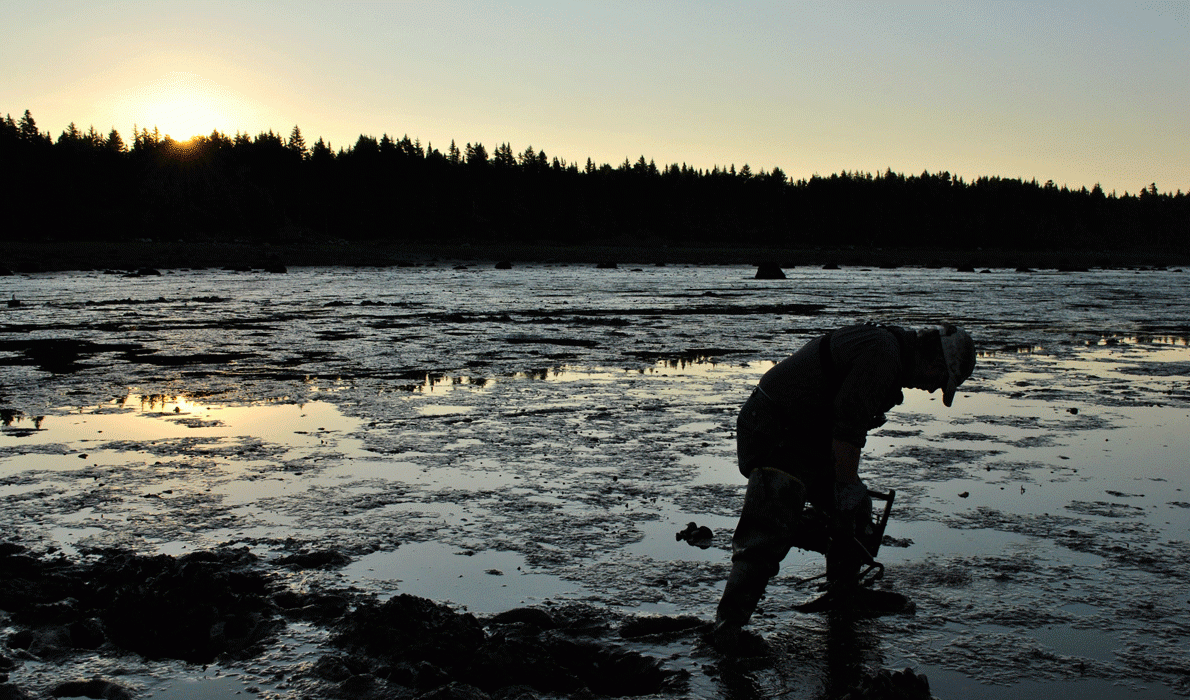Posted July 11, 2018
Last modified July 11, 2018
By Susie Arnold, Jessica Gribbon Joyce and Roger Stephenson
Mainers likely have heard about the precipitous decline in soft-shell clam landings over the last five years. While the fishery remains the third most valuable fishery in the state at over $12 million, licenses have declined over the last several decades and landings are following suit.
In 2017, landings dropped to 6.9 million pounds from 11.3 million pounds in 2013, and the value dropped $3.8 million from 2016. In addition to economic benefits, this fishery is an integral part of Maine’s culture, and clams are key to the intertidal ecosystem.
The major causes for population decline are predation by green crabs, milky ribbon worms, and other species, as well as other impacts of a changing climate, like ocean acidification. Solutions to some of these stressors have been proposed by industry members, the research community, and managers.
Restoration ideas range from collecting wild seed or buying cultivated clam seed and then planting it in the intertidal zone and protecting it with netting, to instituting rolling harvesting closures, and changing minimum and/or maximum harvest sizes. Some of these measures have been implemented in areas of the coast.
In addition, the annual Maine Fishermen’s Forum brings stakeholders together to give updates on the latest in science, management, outreach, and education.
Some of the ideas raised at the forum this year included the need for data collection and resource surveys to better inform conservation and management. Tim Sheehan, a shellfish dealer in Pembroke, asserted that baseline data “that reflects the actual digger’s efforts on the flats” is needed. “They are the citizen-scientists out there each and every day.”
Gathering this information would build on existing landings data. Using landings as a proxy for the status of clam populations is one method, though there are other indicators that can be used when assessing the status of the resource.
One of these indicators is a biological survey of the resource, which is done with scientists, industry members, and other volunteers, generally utilizing a quadrat, or square tool to randomly sample (i.e. count) and measure the number and size of clams in a particular area. Many Maine municipalities conduct these surveys with members of their shellfish committees, license holders, shellfish wardens, and sometimes with support from Department of Marine Resources biologists or other researchers.
Another indicator to supplement surveys is effort data, which is referred to as Landings Per Unit Effort, or LPUE, which provides finer resolution data to help understand how the number of people harvesting clams and days on the water correlate with the volume landed in a particular area.
For fisheries in general, collecting and analyzing these data sources is typically under the authority of a state and/or federal management agency. However, in the case of soft-shell clams, and several other species of bivalve shellfish in Maine, management is shared between the municipalities that have authority over their intertidal zone and DMR. Thus, collecting data and assessing the population size is also shared.
The municipal shellfish committees know their local resources and have a say in how many, when, and where clams are harvested in their ordinances, and the state provides overarching regulations, support from biologists, and water quality and biotoxin monitoring services to ensure clams are safe to eat. While there are benefits to this approach of co-management, there are also drawbacks.
Under good conditions and in the past, this “shared” management model has sustained the resource. However, the rapidly changing environment today requires a heightened level of coordination and communication, and ready access to good data and its implications. Under these conditions the state and municipal bodies could improve their ability to make more informed and timely decisions to adapt to the changes we are seeing, for example, an increase in predation by green crabs.
If Maine is going to be resilient in the face of this rapid change, the industry should build upon recommendations that emerged at the Maine Fishermen’s Forum’s shellfish focus day:
- increase coordination among municipalities and other partners in a shared watershed or region;
- increase coordination and collaborative data collection among industry members, municipalities, and DMR;
- improve communication and training related to proven research and management practices to conserve soft-shell clams;
- obtain sufficient funding for continued research, through state, federal and private funding sources.
If we don’t take immediate steps on this call to action with wild clams, then we will need to look towards aquaculture methods to maintain access to this important species. The risk, as characterized by Bailey Bowden, a harvester from Penobscot is that, “Our iconic boiled lobster with steamers dinner will soon be boiled lobster and raw oysters.”
Susie Arnold is an ecologist and marine scientist with the Island Institute. Jessica Gribbon Joyce is principal of Tidal Bay Consulting and has been a member of Cumberland's shellfish conservation commission for over nine years. Roger Stephenson serves on the policy advisory committee for New Hampshire Sea Grant, and on the management committee for the Piscataqua Region Estuaries Partnership. He works for the Union of Concerned Scientists in New England.

Soft-shell clams




